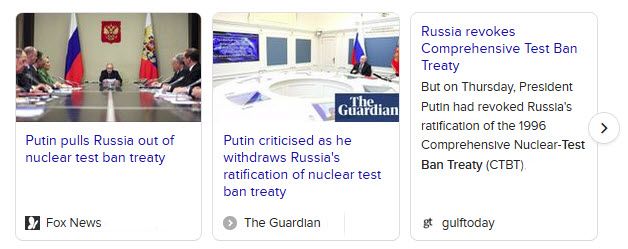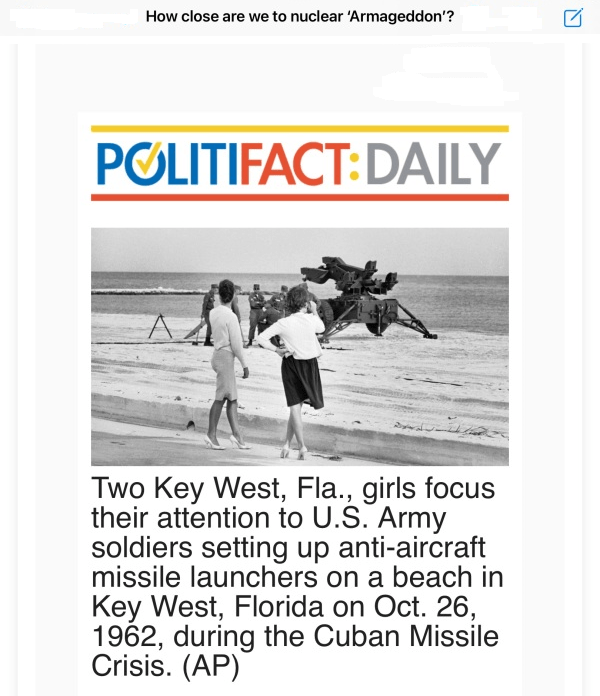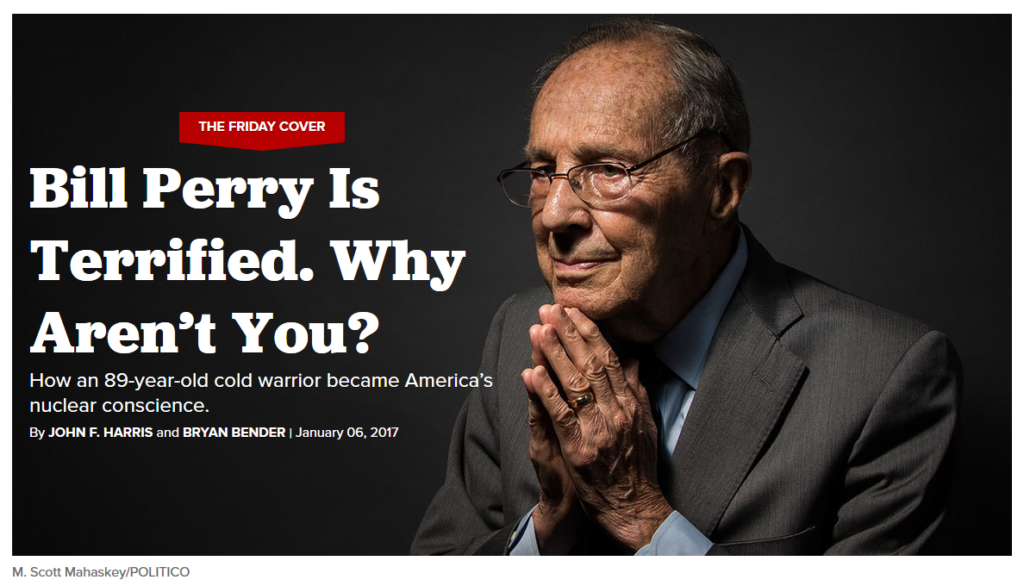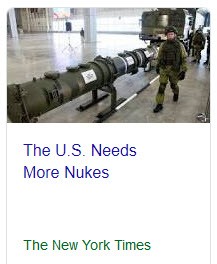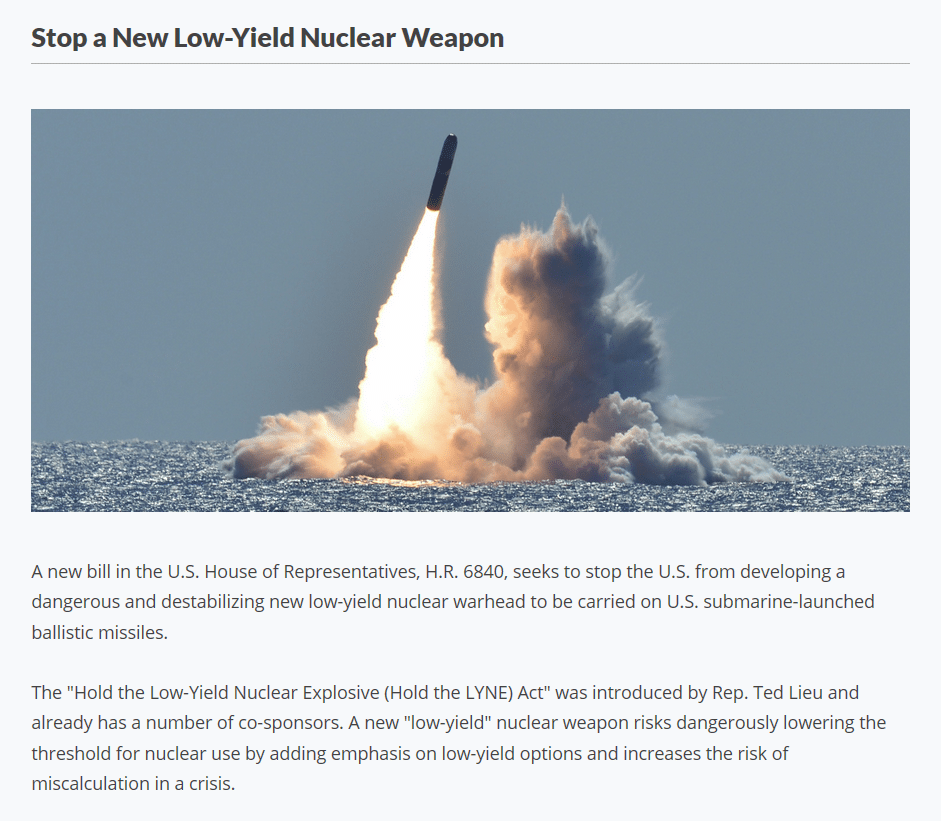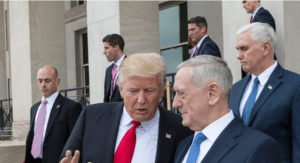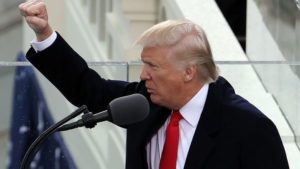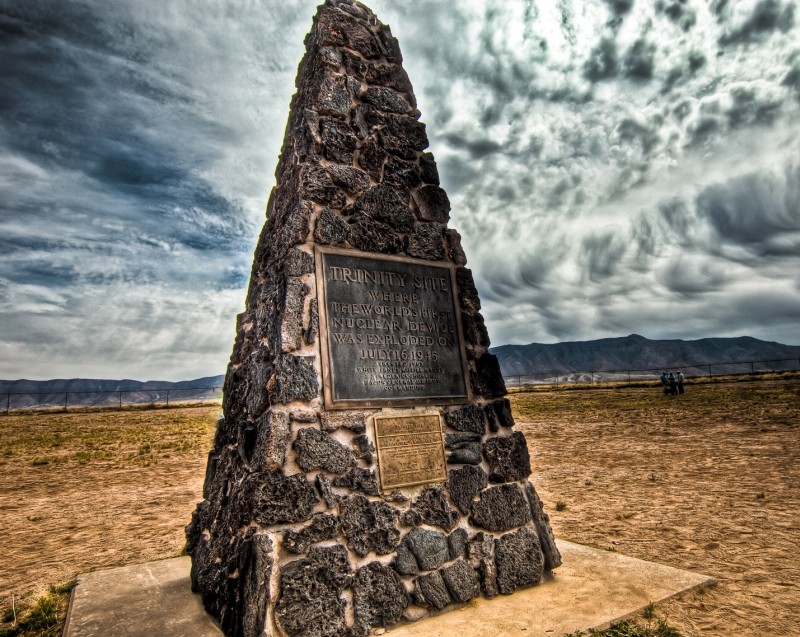
‘On Nuclear Weapons’…
‘The U.S. is now spending annually, in constant dollars, more than three times what the US did for comparable activities during the Cold War.’ (2022/LASG)

2024
WASHINGTON – MARCH 11, 2024
The Department of Energy’s National Nuclear Security Administration (DOE/NNSA) released its portion of President Biden’s Fiscal Year 2025 Budget. The proposal reflects a demanding, expanded mission…
It will advance nonproliferation [StratDem: No, it advances and accelerates a Cold War 2.0 and a Nuclear Arms Race 3.0] and nuclear security efforts in response to deteriorating strategic stability conditions…
“President Biden’s FY 2025 Budget reflects today’s real-world conditions and our need to deliver while transforming the Nuclear Security Enterprise,” said Under Secretary of Energy for Nuclear Security and NNSA Administrator Jill Hruby. “We appreciate the long-standing bipartisan and bicameral support from Congress that allows us to design and deliver a modernized stockpile, forge solutions with allies and partners that enable global security and stability, power a global naval fleet, and leverage transformative technologies to stay ahead of emerging challenges.”
The request is fully informed by and supports the President’s Nuclear Posture Review and National Security Strategy, (and) is aligned with Department of Defense…
StratDem: A tragic legacy of ‘the Bomb’
Those who envisioned, designed and built the Bomb began warning of nuclear dangers and proliferation even before the Bomb was first used in Hiroshima and Nagasaki….
See GreenPolicy360’s review of the film Oppenheimer and the Siterunner’s recollections of a life working against nuclear weapons proliferation.
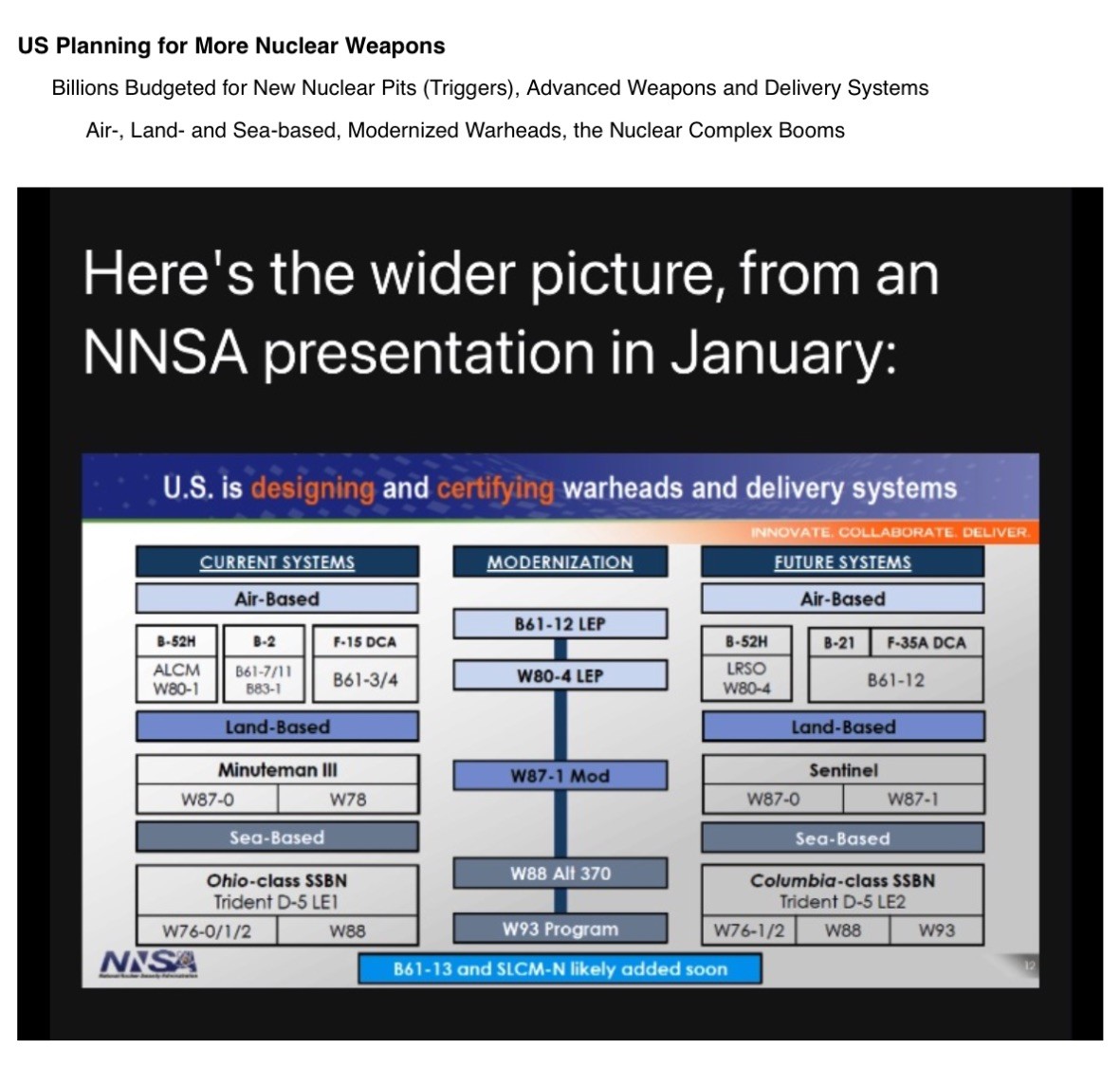
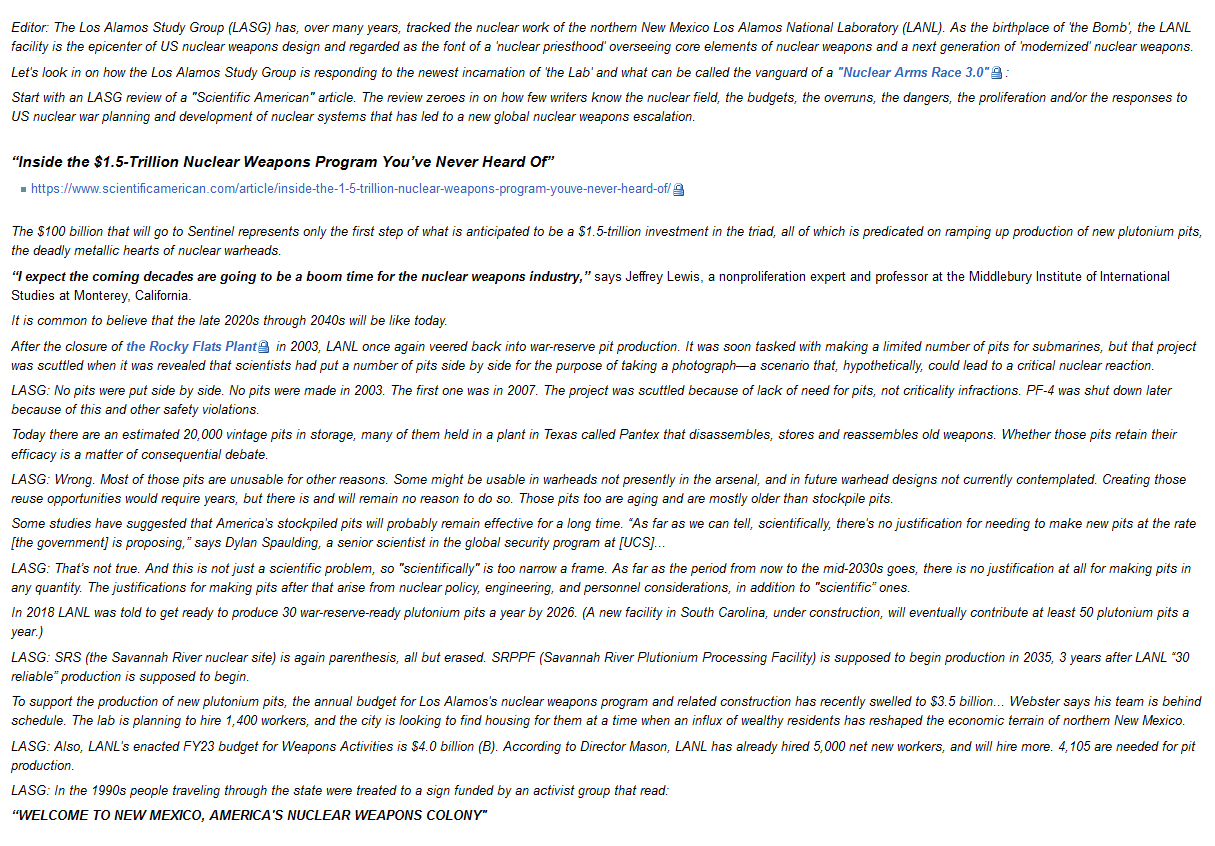
2023
Strategic Demands’ 1.0 to 3.0 Nuclear Arms Race classification
The following provides a development chronology of the ‘Cold War’ and ‘Nuclear Arms Race’.
From Trinity Site beginnings in a desert called Jornada del Muerto in New Mexico, near ‘the National Lab’ in Los Alamos that was the ‘birthplace of the Bomb’ until today, were a new, increasingly dangerous era of nuclear proliferation. The world looks on…
Arms Race 1.0 — The origins of the nuclear arms race, as predicted by many, began with the test of the Soviet Union’s first nuclear weapon in 1949. This era last through the 1950s and development of thermonuclear weapons, testing, and ended with the confrontation and near-use of nuclear weapons between the United States and Soviet Union during the October 1962 Cuban Missile Crisis.
Arms Race 2.0 — The imminent demise of 1962 prevented by a Kennedy-Khrushchev agreement, led to a series of agreements to draw down, over years, each countries nuclear weapons arsenals. From the mid-1960s ti the late 1990s, a profound number of nuclear and weapons of mass destruction treaties/agreements were signed. Thousands of nuclear weapons were by treaty taken out of the US and Soviet (Russian) arsenals, many of them were the most lethal, largest city- and region-destroying weapons that scientists were predicting would bring on global devastation and ‘nuclear winter‘. This era of nuclear development, which included a brief opportunity for a ‘peace dividend‘ and further nuclear drawdown after Soviet Union became the Russian Federation, came to a close in 2001 with war in the Mideast/Near East with the announcement of the US Bush Doctrine memorializing ‘right’ of first strike, preemptive war
Arms Race 3.0 — Announced ‘modernization’ of US nuclear weapons systems has, as Strategic Demands presents, led to a collapse of nuclear weapons treaties and weapons systems drawdown. The current era presents collapse of monitor and verification treaties. The rapid scaling up of nuclear weapons and delivery systems by the People’s Republic of China/CCP and nuclear weapon holding countries including North Korea, India, Pakistan, Israel is occurring in a backdrop of war and increasing risks of use. The Russia-Ukraine war has brought a resurgent NATO-EU policy with ‘full-dimension’ air/land/sea warfare supported by US deployments of nuclear weapon delivery platforms, including — B-15/B-2/B-52/F-35 ‘strike forces’ and various iterations of cruise missiles and tactical nuclear weapons. Russia and China have drawn closer. Mutual security, ‘entangling alliances’, emerging threats and risks of miscalculation, mistake, or misjudgment, bringing on a nuclear exchange, are all too real. Nuclear Arms Race 3.0 is now beyond dangerous…
Too Close to “the Apocalypse”
Cold War 2.0
November 2023
One by one, international nuclear agreements fall…
The End of the Comprehensive Nuclear-Test Ban Treaty
February 2023
Nuclear Weapons @ GreenPolicy360
The End of New START
We should have known but we didn’t know and we didn’t act upon what we should’ve known and acted upon.
A multi-billion dollar ‘modernization’ of US nuclear weapons has delivered an accelerating ‘next gen’ nuclear arms race.
Strategic Demands has been calling this nuclear weapons modernization — with its consequences — a “Cold War 2.0”. Now, with an announced ‘suspension’ of the New START treaty that was negotiated with immense effort, the final remaining US-Russia strategic nuclear arms agreement has collapsed. Now, nuclear systems modernization has led to a next-gen deadly game of move-countermove… and China is full force into this ‘Nuclear Arms Race 3.0’. The US modernization of the nuclear weapons systems and the breakdown of nuclear arms control agreements has led the world into a next generation of nuclear cold war.
Acknowledging strategic reality … “3.0” nuclear arms race has commenced
2022
Conditions Going Bad to Worse in Ukraine

StratDem Editor: Some would say it’s “Code Red” as the Russia-Ukraine war escalates on the ground and in strategic war rooms. Six plus months after the February 24, 2022 Russian ‘invasion’ into Ukraine, the war widens and threats of nuclear weapons continue to spiral.
No one should take these nuclear threats lightly. Nuclear weapons experts, ‘think tanks’, academics and varied politicians are pointing at nuclear use as a matter of course, as if nuclear weapon use — and the reciprocation that will follow — is now a ticking bomb. When, why, how and under what authority will nuclear weapons be used is being ‘normalized’ as a topic of discussion in media outlets. This ‘how it could happen’ comes as Russian media reports increased threats and increased setbacks — and U.S. media reports a president warning of a “prospect of Armageddon’, comparing the present moment to the “Cuban Missile Crisis’ of some sixty years ago.
The Russian policy on nuclear use is being circulated, the U.S. policy on nuclear use, that has no prohibition on “first use”, is being discussed as a type of contingency planning.
The increased possibility of what is described as ‘miscalculation’, ‘mistake’, ‘disaster’, ‘catastrophe’, ‘apocalypse’ and ‘Armageddon’ are now being examined in ways not seen since the Cuban Missile Crisis.
The worst moments of humanity’s near ‘end of times’, as some describe it with religious fervor, have returned.
We at Strategic Demands proposed numerous diplomatic solutions prior to the outbreak of war in Ukraine, addressing seemingly intractable issues such as expansion of NATO and its next-gen nuclear weapons toward Russia’s border and a perceived existential threat to the nation by current Russian leadership. A host of other perceived and real conflict nexus threats were being aired and address, when the hammer dropped, war commenced. Recriminations aside, now, as many predicted, dire consequences are rolling out with the most consequential of all being pushed publicly.
The internet today, October 11, delivered to StratDem the following. We share the message — ‘How close are we to nuclear ‘Armageddon’? — as another warning of an increasingly predictable outcome of this war.
Now what is needed are off-ramps, diplomatic solutions, ways to end this ‘hot’ war with potential to impact all nations, all people, all life on earth. Now we must take the overwhelming U.S. might and dominance and shift to sober intelligence.
Now what is needed is not a knee-jerk ‘ratcheting up’ of hostilities with a horrible story ending, but a ‘winding down’. The alternative is …. unthinkable.
February 2022
Washington Post | Opinion: Putin’s nuclear threats remind us that nuclear weapons agreements are collapsing and arms control is dangerously unfinished business
Collapsing Nuclear Arms Control Agreements
Lost opportunity for nuclear arms control agreements and ‘mutual security’
* https://www.greenpolicy360.net/w/Nuclear_Nonproliferation
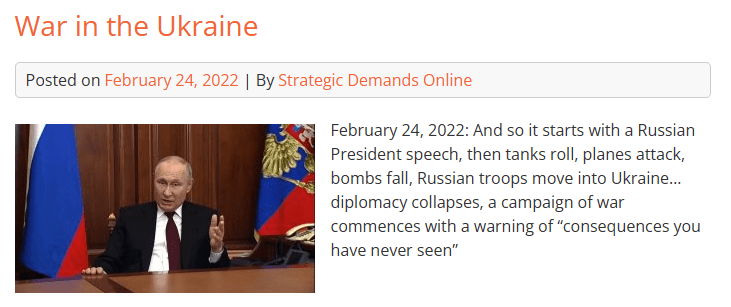
February 24, 2022:
And so it starts with a Russian President speech, then tanks roll, planes attack, bombs fall, Russian troops move into Ukraine… diplomacy collapses, a campaign of war commences with a warning of “consequences you have never seen”
Shortly after midnight / Ukraine
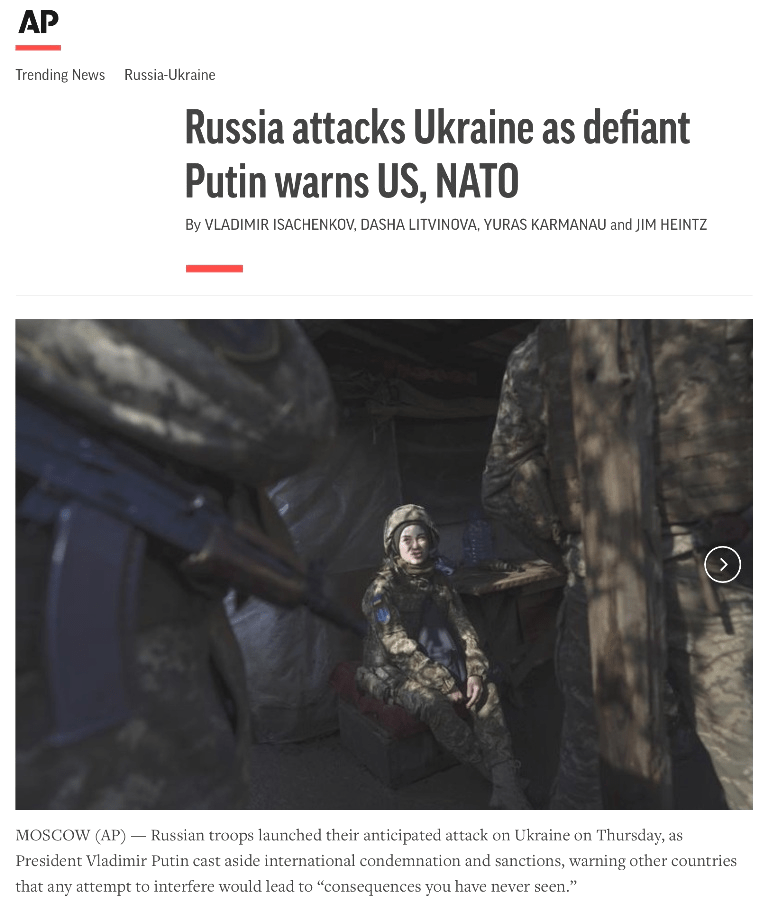
The Ukraine-Russia Crisis and Threats of Nuclear Weapons Use
Mid-afternoon / U.S. East Coast Time / February 24, 2022
(AXIOS)
Rarely in our lifetimes has the world heard more chilling and ominous words: Vladimir Putin said nations “will face consequences greater than any you have faced in history” if they interfere in his invasion of Ukraine.
Why it matters: This is a rare overt threat of nuclear attack…
Putin said in announcing the invasion:
To anyone who would consider interfering from the outside: If you do, you will face consequences greater than any you have faced in history. All relevant decisions have been taken. I hope you hear me.”
(CNN)
After Russian President Vladimir Putin announced he had ordered military action in Ukraine early Thursday, he threatened “those who may be tempted to intervene” on Ukraine’s behalf.
“Now a few important, very important words for those who may be tempted to intervene in ongoing events from the outside,” Putin said.
“Whoever tries to interfere with us, and even more so to create threats to our country, to our people, should know that Russia’s response will be immediate and will lead you to such consequences as you have never experienced in your history. We are ready for any development of events. All necessary decisions in this regard have been made. I hope that I will be heard.”
(NYT)
In a rambling speech early Thursday, full of festering historical grievances and accusations of a relentless Western plot against his country, Mr. Putin reminded the world that Russia “remains one of the most powerful nuclear states” with “a certain advantage in several cutting edge weapons.”
In effect, Mr. Putin’s speech, intended to justify the invasion, seemed to come close to threatening nuclear war.
In the context of Russia’s nuclear arsenal, Mr. Putin said, “there should be no doubt that any potential aggressor will face defeat and ominous consequences should it directly attack our country.”
(POLITICO)
“Suddenly, the ‘unthinkable’ is unfolding before our eyes.” For context, “new deployments of nuclear weapons in Eastern Europe could station US and Russian nuclear weapons closer than at any time in history… this would not be a second Cuban missile crisis but a far more volatile situation.”
(TELEGRAPH UK)
Vladimir Putin appears to threaten nuclear strikes if West launches reprisal attacks
Russian president warns that any attempt to interfere in Ukraine conflict will provoke a response ‘never seen in history’
In a stark reminder of Russia’s nuclear power, he warned that “no one should have any doubts that a direct attack on our country will lead to destruction and horrible consequences for any potential aggressor”.
The address amounted to a declaration of war on Ukraine, with the aerial bombardment and invasion following shortly afterwards.
More:
A BBC and NYT fact check: Nukes, Proliferation and the Ukraine crisis —
* https://www.bbc.com/news/60477712
* https://www.nytimes.com/2022/02/23/us/politics/putin-ukraine-nuclear-weapons.html
Mutual security and threat of nuclear weapons use demands an expanded INF agreement
Act Now to Expand the INF Agreement

StrategicDemands: Extend and Expand the Intermediate-Range Nuclear Forces Treaty
* https://www.armscontrol.org/factsheets/INFtreaty
Update / February 2, 2022
In a story released early today by elpais.com, presented as an “exclusive”, we are offered an inside look at U.S. – Russia Ukrainian negotiations… We now have to point to Strategic Demands earlier proffered diplomatic solution — to focus on mutual security as our StratDem logo tag states “Security is Indivisible”. Perchance mutual security has found resonance.
In paragraph 4 of the elpais.com ‘exclusive’ article a reference is made to the Organization for Security and Co-operation in Europe (OSCE) and goes on to say “Washington is prepared to discuss the concept of ‘indivisibility of security'”.
* https://english.elpais.com/usa/2022-02-02/us-offers-disarmament-measures-to-russia-in-exchange-for-a-deescalation-of-military-threat-in-ukraine.html
The main difference between both texts is that Washington is prepared to discuss the concept of “indivisibility of security,” which the OSCE approved at its summit in Nur-Sultan, Kazakhstan in 2010. Moscow has included this in the first article in its draft deal, using this principle to allege that the eventual entry of Ukraine into NATO would affect its security. The text from the US warns that it does not share the Russian point of view and notes that the concept of indivisibility of security “cannot be viewed in isolation.” Even so, it expresses willingness to deal with the “respective interpretations” of the same. And it points out that “the United States and Russia also reaffirmed the inherent right of each and every participating state to be free to choose or change its security arrangements, including treaties of alliance.”
Later in the day, U.S. spokesperson John Kirby referred to the negotiation documents written about by elpais.com and stated the U.S. willingness to negotiate with Russia. Mutual security, ‘security is indivisible’ as a principal is on the table and in negotiation!
* https://english.elpais.com/usa/2022-02-02/pentagon-says-documents-published-by-el-pais-show-us-is-willing-to-negotiate-with-russia.html
Pentagon spokesman John F. Kirby said on Wednesday that the confidential documents published exclusively by EL PAÍS – and which included the responses by Washington and NATO to Russia’s requests for security guarantees – show that the United States has the willingness to negotiate with the Kremlin in order to solve the crisis in Ukraine.
Kirby mentioned the documents in his opening remarks ahead of a news conference at the Department of Defense. “We did not make this document public, but now that it is, it confirms to the entire world what we’ve always been saying: there is no daylight between our public statements and our private discussions.”
StratDem continues to advocate for solutions that move nations toward mutual security and nuclear nonproliferation. This confrontation at the border of Ukraine provides in its charges of insecurity and claims of aggression comes an opportunity to move toward broad-range solutions that address nuclear and potentially cataclysmic challenges.
Amid the rattling of swords and ‘modernization’ of nuclear forces, the forward positioning of ground- and air-based tactical and nuclear weapons, comes a generational opportunity to drawdown and step back from mutual nuclear insecurity.
* https://strategicdemands.com/a-proposed-ukraine-fix-act-now-to-expand-the-inf-agreement/
February 1, 2022
Russian President Vladimir Putin, speaking at a Tuesday news conference following a five-hour meeting in Moscow with Hungarian Prime Minister Viktor Orban:
“It is already clear — I informed the Prime Minister about this — that the fundamental Russian concerns were ignored [in the U.S. response]. We did not see an adequate consideration of our three key requirements.” Russia had not seen, he explained, “adequate consideration of our three key demands regarding NATO expansion, the renunciation of the deployment of strike weapons systems near Russian borders, and the return of the [NATO] bloc’s military infrastructure in Europe to the state of 1997, when the Russia-NATO founding act was signed.”

A Proposal for Joe Biden & Vladimir Putin
Strategic Demands to Presidents Joe Biden and Vladimir Putin: Step back from the brink
Order your ambassadors to focus on achieving ‘mutual security’
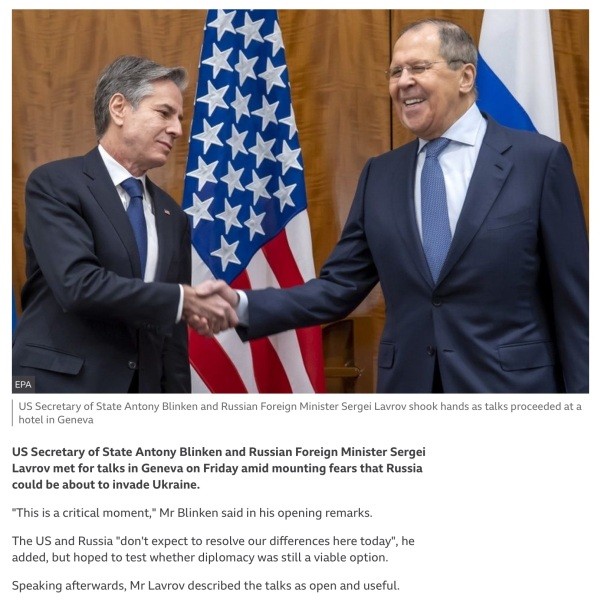
Address the nuclear weapons, tactical and strategic, extension of the INF treaty, expansion of NATO, nuclear weapons ‘modernization’ attached to enhanced nuclear weapons controls. Real, mutually verifiable security.
Intermediate-Range Missiles Are a Focal Point in the Ukraine Crisis: The Stalled INF Negotiation Can Provide the ‘Fix’ to the Ukraine Crisis
Nuclear Weapons in Europe … Tactical/Strategic Background
Security Perspectives, Security Demands: Russia, Ukraine, NATO, US, European nations
If one steps back and takes a broader look at the causes of potential war over the issue of Ukraine, the issue takes on a larger security perspective, i.e., nuclear weapons “modernization” and next generation “smart”, “dial-up” tactical nuclear weapons imminently being deployed in Europe and other theaters.
The modernization of nuclear weapons post Cold War nuclear triad strategies, and the Mutually Assured Destruction (MAD) era of massive nuclear retaliation with ‘launch on warning’ command and control to assure land-based missile capabilities can respond to perceived preemptive attack, has led to a new era, one of so-called small nukes.
They are not small, they are profoundly dangerous to real security. The current European, East-West standoff with Russia over Ukraine, NATO expansion and next gen nuclear weapon delivery systems and capabilities demonstrate how the coming nuclear weapons are bringing on new iterations of nuclear danger.
A realistic, mutual security approach to the INF agreement, elevated to immediate highest priority, can become the necessary security fix to step back from a war in Ukraine.
Mutual security is the goal to be achieved.
Security here is indivisible.

Notes:
“Examining the United States and Russia’s differing responses to the demise of the Intermediate-Range Nuclear Forces Treaty highlights the interconnectedness of these events and the failure of the nations to communicate. While Russia’s threats are fundamentally tied to maintaining influence over Ukraine and deterring NATO expansion, a renewed focus on arms control can still play a role in finding a peaceful resolution.”
Why Intermediate-Range Missiles Are a Focal Point in the Ukraine Crisis
”Russia’s proposal for ending the current crisis stipulates that the United States “not deploy land-based intermediate- and short-range missiles in areas allowing them to reach [Russian territory].”
* https://mid.ru/ru/foreign_policy/rso/nato/1790803/
* https://mid.ru/ru/foreign_policy/rso/nato/1790803/?lang=en
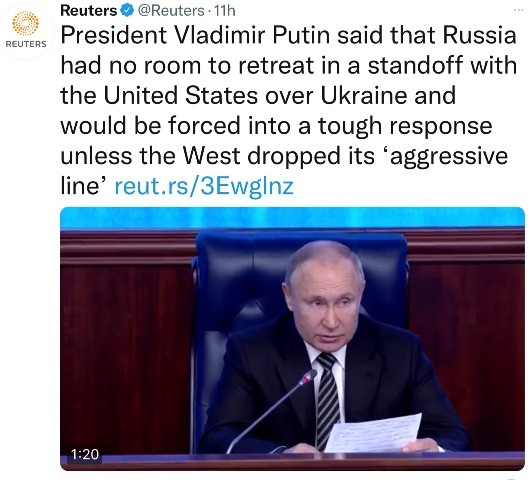
No nuclear weapons control breakthroughs, no forward-looking nuclear arms control agreement, instead we have predictable reaction of China and the Russian Federation, a ratcheting up of nuclear weapons development, spending and international proliferation as Strategic Demands has pointed out for over a decade.
The predictable result of failed security policy is a new Cold War 2.0 heating up…

Our advice to President-elect Biden: Break the dangerous pattern of nuclear competition with Russia
By Jerry Brown, William J. Perry, David Holloway | January 18, 2021
Via the Bulletin of the Atomic Scientists
* https://thebulletin.org/2021/01/my-advice-to-president-elect-biden-break-the-dangerous-pattern-of-nuclear-competition-with-russia/
(Open Letter)
Dear Mr. President-elect,
After the most bizarre presidency in US history, you are now about to take charge and begin restoring a sense of normalcy to our troubled nation. But these are anything but normal times, and your task will be enormous.
The pandemic, the brazen attempts to overturn the presidential election, and now the assault on the Capitol itself make this a period of profound uncertainty. The challenges are both domestic—getting the coronavirus vaccine distributed and the economy rejuvenated—and foreign. Trump undermined our alliances and withdrew America from hard-fought agreements such as the Paris climate accord and the Iran nuclear deal. He also repudiated important agreements with Russia. Achieving the goals set at Paris and getting the Iran deal back on track will be difficult. But the most arduous task will be putting our relations with Russia on a safer path and breaking the dangerous pattern of repeated escalation of tension between the two countries.
Russia poses the most serious threat imaginable to the United States; it could launch—possibly by mistake or miscalculation—hundreds of nuclear missiles, with absolutely catastrophic consequences. We, of course, pose a similar threat to the Russians.
While everyone knows this at some level—that an absolutely catastrophic US-Russian nuclear blunder is possible—few political leaders call for a resumption of even the level of dialogue that once existed between America and the Soviet Union. Name calling, sanctions, and outrage are the order of the day, while the older practice of serious dialogue among civilian, military, and scholarly experts is frowned upon or not widely appreciated. When there is trouble—like the recent massive intrusion into US government computer systems—the preferred US response is to punish Russia by curbing communication. This is a huge mistake.
As with the Soviet Union during the Cold War, Russia today is an essential partner in managing the global nuclear order—in spite of the hostile relations between our two countries. It was cooperation between the United States and the Soviet Union that made the 1968 Nuclear Non-Proliferation Treaty possible. More recently, Russia played a key role in negotiating and implementing the Iran Nuclear Deal.
In light of this, your announced intention to extend New START, which will otherwise expire on February 5, is absolutely the right step to take. It will enhance the predictability of our strategic relationship with Russia and provide time for negotiating new agreements or understandings with Russia—and ideally with China, too. Revival of the Iran nuclear deal is also a vitally important goal to pursue.
It’s long past time that we honestly confront the addictive and self-reinforcing quality of our current tit-for-tat relationship with Russia—one that perpetuates ever-higher nuclear spending and ever-higher levels of danger. Each nuclear ratchet upward by one country provokes a reciprocal nuclear response.
The United States must deal with Russia as it is, not as we wish it to be. This means engagement and diplomacy on the issue that threatens all of humanity. Article VI of the Nuclear Non-Proliferation Treaty requires Russia and the United States to “pursue negotiations in good faith on effective measures relating to cessation of the nuclear arms race at an early date.” Too often, and especially in recent years, we have blatantly shunned this obligation—in part, because of actions Russia has taken that we Americans find unacceptable. But that is not what the treaty permits, and it is not what makes sense.
In this current state of dismal relations, dialogue is not a reward or an exercise of naivete; it is an imperative for survival. When things are bad—as they are now—is precisely the time to talk.
Only you, Mr. President, can make that happen.
······································································································································
Strategic Demands Reporting on Nuclear Risk
Witnessing the End of Nuclear Weapons Control
End of the INF, New START — the Global Architecture Collapses
More Nukes
The US Needs What?
December 2020
‘The U.S. is now spending annually, in constant dollars, more than three times what the US did for comparable activities during the Cold War’
Via Los Alamos Study Group, Santa Fe, New Mexico
- http://www.lasg.org/press/2020/press_release_22Dec2020.html
- http://www.lasg.org/press/2020/press_release_29Dec2020.html
LASG: The Weapons Activities funding provided by Congress in this bill is greater — both in absolute amount in constant-dollars and in year-on-year growth — than at any prior time in U.S. history.
H.R. 133 funding for the National Nuclear Security Administration (NNSA)…
Overall, Congress appropriated $19.73 billion (B) for NNSA …
As the US Develops More Nukes and More ‘Usable’ Nuclear Weapons under the Umbrella of ‘Modernization’ of the Nuclear Arsenal
StratDem: The four years of the Trump administration has produced a collapse of nuclear arms agreements and a new U.S. rush to produce a next generation of ‘usable’ nuclear warheads and delivery systems.
Think about what’s going thru the minds of North Korea, China, Russia… think about the collapse of INF negotiations, the end of New START negotiations… consider how one after another of the previous generations nuclear weapons agreements are ‘biting the dust’ … ask yourself how any potential for constructing lasting nuclear agreements comes about as the hard-won agreements are peremptorily abandoned. Those who deconstruct the arms control will have a legacy to live with and it is one of less security and greater national and global security risk.
As the US unilaterally abandons, withdraws from, violates or sets aside (pick ur phrase) existing arms control agreements, the consequences will be judged.
Recall this language in the JCPOA. Paragraph 26 of the Joint Comprehensive Plan of Action (JCPOA) states: The United States will make best efforts in good faith to sustain this JCPOA … and to prevent interference with the realisation of the full benefit by Iran of the sanctions lifting specified… The U.S. Administration, acting consistent with the respective roles of the President and the Congress, will refrain from imposing new nuclear-related sanctions. Iran has stated that it will treat such a re-introduction or re-imposition of the sanctions specified in Annex II, or such an imposition of new nuclear-related sanctions, as grounds to cease performing its commitments under this JCPOA in whole or in part.
The President of the United States (phone in hand)…
July 22, 2018, 11:24 PM EST in the White House. Fingers on his Twitter keypad.
Recalling his “first order”, the US president plays a nuclear card as he tweets a late-night threat to the Iranian President and people of Iran.
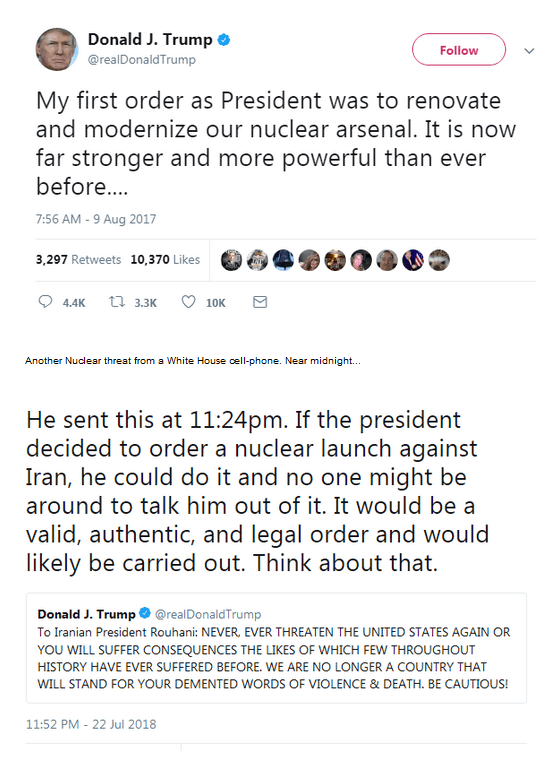
February 2018: Nuclear Weapons Time, ‘Usable’ Nukes on the Horizon
2017
Strategic Demands proposes Congressional legislation to limit presidential authority to order first-use of nuclear weapons
Via Washington Post / Fall 2017
Analysis / Trump’s Request for More Nuclear Weapons
#StratDem Comments
Extremely dangerous. Damaging to national and global security. Accelerant to nuclear proliferation globally.
China-Russia and nuclear states will now, in turn, multiply nuclear weapon systems far beyond current spending …
Cruise nukes are esp threatening. Read former Sec of Defense Bill Perry. The push toward ‘usable’ nukes is serious threat on near horizon.
Stephen F. Cohen / Summer 2017
“We’re at maybe the most dangerous moment in US-Russian relations in my lifetime, and maybe ever. And the reason is that we’re in a new cold war, by whatever name. We have three cold war fronts that are fraught with the possibility of hot war, in the Baltic region where NATO is carrying out an unprecedented military buildup on Russia’s border, in Ukraine where there is a civil and proxy war between Russia and the west, and of course in Syria, where Russian aircraft and American warplanes are flying in the same territory. Anything could happen.”
President Trump setting the stage
President Trump has called for a new global arms race, and the Pentagon is ready.
Trump’s newly released budget for 2018 contains hundreds of millions of dollars to speed up development of the Long Range Stand Off missile — a jet-propelled nuke designed to be launched from an airborne bomber and stealthily zip to a target virtually anywhere in the world.
It will carry a “variable yield’’ warhead that can be adjusted to deliver an atomic blast ranging from 5 to 150 kilotons — that is, from about one-third of a Hiroshima-sized bomb to as much as 10 Hiroshima bombs…
“This weapon makes fighting nuclear wars even more possible. Its accuracy and potency will be greater. We don’t need it. It’s dangerous. And the weapons that we have already can do the job,’’ said Senator Edward Markey, the Massachusetts Democrat and longtime proponent of a freeze and reduction on nuclear weapons.
“We’re going to ask other countries to engage in restraint while we’re making . . . nuclear war-fighting even more possible, even more imaginable.”
“I miss it, the Cold War. It gave you a reason to get up in the morning.”
— Harry “Rabbit” Angstrom, in John Updike’s Rabbit at Rest (1990)
http://billmoyers.com/story/sleepwalking-nuclear-arms-race-russia/
Sleepwalking Into a Nuclear Arms Race with Russia
The nuclear issue boils down to a question of understanding how America’s spending decisions and actions impact patriotic Russians.
- https://www.nytimes.com/2017/02/27/us/politics/trump-budget-military.html
- http://www.reuters.com/article/us-usa-trump-idUSKBN1622IF
- https://twitter.com/realDonaldTrump/status/811977223326625792
The Bulletin of the Atomic Scientists takes the unprecedented step of moving the Doomsday Clock ahead 30 seconds, moving the nuclear hands of the clock to 2½ minutes to midnight …
Thirty seconds closer to midnight…
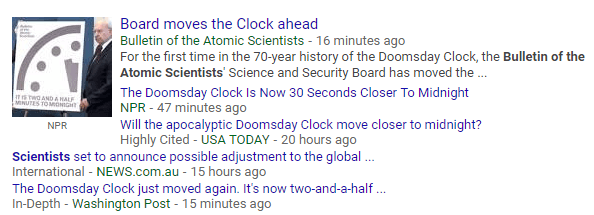
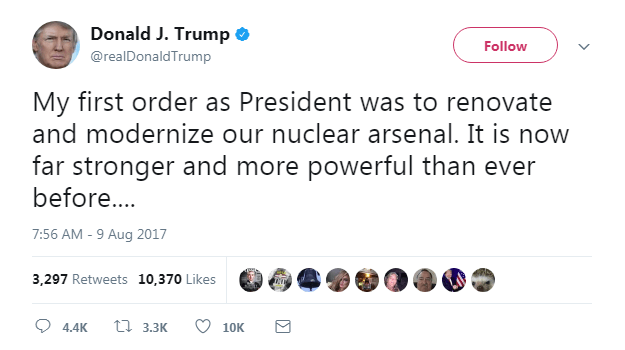
Trump’s Nuclear Options
- New START. What is it? Trump: It’s a bad deal!
- In call with Putin, Trump denounces Obama-era nuclear arms treaty
Hypersonic Nuclear Weapons on the Horizon
Russia has unveiled the first image of a new thermonuclear-armed intercontinental ballistic missile, the RS-28 Sarmat. The Sarmat, designed to be fitted with a hypersonic glider warhead, is expected to go into production as early as 2018. US and Chinese hypersonic nuclear weapons, land-, sea-based, air-launched, stand-off cruise missiles in accelerated active development/testing
Calculus of War; Hypersonic Arms Race
Ⅰ Ⅱ Ⅲ Ⅳ Ⅴ Ⅵ Ⅶ Ⅷ Ⅸ Ⅹ Ⅺ Ⅻ
2016
As the US Preps for a New President
Now is the time to set in place additional protection against first-use
Poll: Nearly half of voters think Trump will detonate a nuke
Donald Trump: “Why are we making them?” … ‘If we have them, why can’t we use them?’
Ⅰ Ⅱ Ⅲ Ⅳ Ⅴ Ⅵ Ⅶ Ⅷ Ⅸ Ⅹ Ⅺ Ⅻ
NextGen Nuclear Weapons and the Codes
Nuclear Arsenal & Reflections on a President’s Last Days in Office / July 2016
Nuclear Use Scenarios / June 2016
New Nuclear Arsenal / June 2016
Hiroshima / May 2016
Stewards of the Apocalypse / May 2016
Recipe for Proliferation / April 2016
My Journey at the Nuclear Brink / January 2016
2015
Remembering a Day in 1962 / October 2015
Next-Gen Nuclear Weapons / October 2015
Mideast Proliferation v Non-proliferation / Sept 2015
The Iran Deal / August 2015
Iran and Diplomacy / August 2015
A Win for Non-proliferation / July 2015
Deal: Now to Implementation / July 2015
A Day in the Life of a Nuclear Arms Race / June 2015
Hair Trigger Revcon / June 2015
Pits: Future of Nuclear Warhead Cores / May 2015
Nuclear Modernization and the NPT / April 2015
“The Edge”, Europe and Russia – Cold War 2.0 / Feb 2015
Blip on the Screen / Jan 2015
Going Bzhrk / Jan 2015
Nuclear Proliferation, Nuclear Arms Race
sh7.ea8.myftpupload.com/?s=nuclear+proliferation
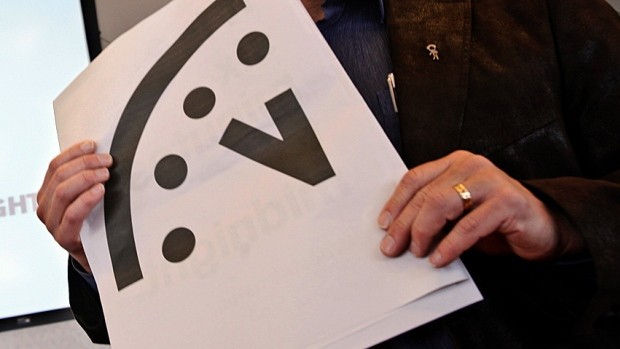
······························································································
Ⅰ Ⅱ Ⅲ Ⅳ Ⅴ Ⅵ Ⅶ Ⅷ Ⅸ Ⅹ Ⅺ Ⅻ
In a desert called Jornada del Muerto
# # # #

